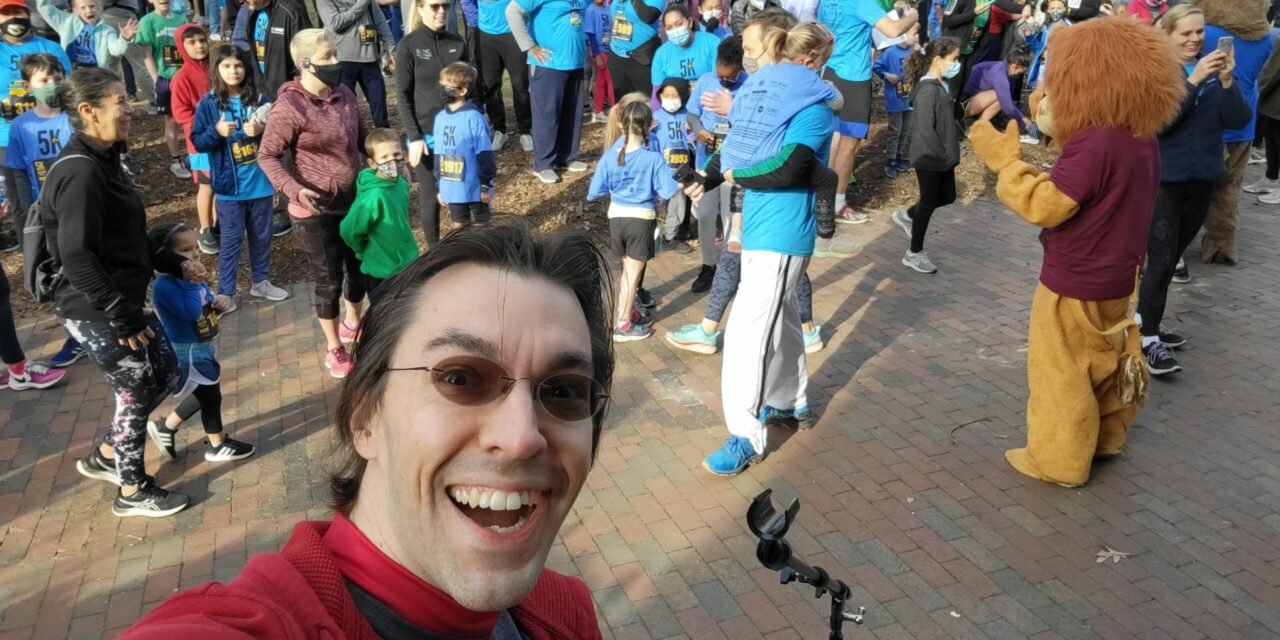Featured photo: since the 2020 5K For Education was my last major gathering before the pandemic, the 5K For Education on March 5, 2022 felt like a full-circle moment.
In the spring of 2020, everything changed.
Everything changed first over COVID-19. People worked from home, others lost their jobs. Overnight, our plans changed. Our needs changed. And the organizations we counted on to meet those needs – they had to change as well.
And something else was happening too. The same week North Carolina closed its schools, a woman named Breonna Taylor was shot and killed by police in Louisville. Two months later, George Floyd was killed in Minneapolis. And as people flooded the streets in protest, once again, we realized things had to change.
It’s now been three years since that spring. What have we learned from our experience? What lessons have we taken away? What changes have we made? And which of those changes will last?
“Three Years” is a series by 97.9 The Hill’s Aaron Keck – looking back on our memories and lessons learned from our collective experience, drawn from conversations with numerous government officials, nonprofit heads, scholars and thought leaders in the Chapel Hill-Carrboro community.
Click here for the entire 15-part series.
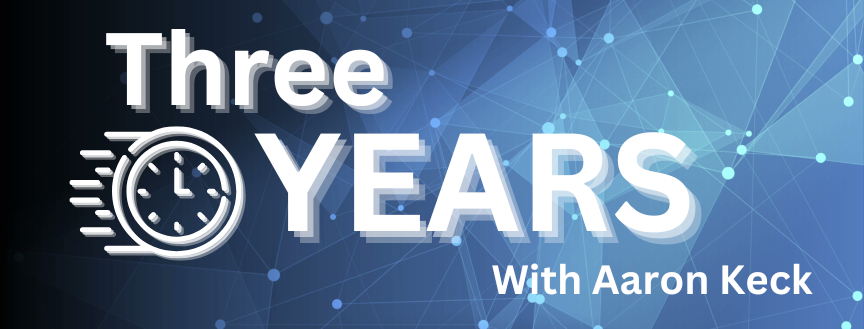
Listen to Chapter 15:
Chapter 15: The Return
“It was about time to start,” says Damon Seils. “So I walked out the front door of Town Hall – and there were hundreds of people. All masked up, most of them with children, and just really excited to be together.”
It’s kind of an open question: when does all this end?
Is it when we officially switch from ‘pandemic’ to ‘endemic’?
Is it the first time we walk into an indoor space without even thinking about a mask?
What moment of normalcy will it be?
Maybe it’s the first ‘normal’ moment that doesn’t feel weird. Because those first ‘normal’ moments felt weird, right? The first trip to a restaurant, the first big gathering, the first show at the Cradle – or the first Christmas tree lighting in Carrboro in 2021, right after Damon Seils was first elected mayor.
“I was not expecting that,” he remembers. “And I certainly – as the new mayor, I was not quite prepared to get up in front of this huge crowd of people. There was this energy in the air – and all my colleagues from the Town Council were there, and we were all kind of arriving on our own, into this space that I don’t think any of us were expecting.”

October 8, 2021: a big milestone in the return to normalcy – our first DPAC show in almost two years.
So where does all this leave us?
With a lot of feelings, and a lot of changes, and a lot of memories.
I remember the first time I heard about COVID-19: some random TV news show about some major city in China that had turned into a ghost town overnight.
I remember being in a packed restaurant in early March – and then walking into another one a week later and being the only customer in sight.
I remember March 27: that was the last day we had an in-person interview on the air for two months.
I remember feeling uncomfortable being in a room with five people in it, wondering why folks didn’t know better.
I remember Sonny Kelly calling in to bare his soul the week after George Floyd was killed.
I remember the emptiness on the roads.
What do you remember?
“I remember the first class I tried to teach that week,” says UNC historian William Sturkey. “And I wrote to all of my students and said, ‘I highly recommend that you do not come to class.’”
He’s talking about UNC’s brief, ill-fated attempt to go back to in-person classes in the fall of 2020.
“I taught a class in person, for the students that really insisted that they wanted to try and be there – and I think there were three of them,” he says. “It was me, in a room that held 180 people, and three students in the audience, and everybody else was on Zoom. Just – it was just such a surreal feeling, to give a lecture in front of three people, in a room that holds 180. That, I’ll probably never forget.”
Now, of course, UNC is back in person – we hope for good – but the effects still linger.
“Let’s just face it: online learning, at least in the context in which we taught, was much easier,” Sturkey says. “You really didn’t have to be engaged. You could literally turn your screen off. And you know, at first I wasn’t telling students ‘you got to have your screen on’ – because they might be at home with their family, there might be kids running around, who knows? You can’t really (demand) that in this moment…
“But now that we’re back in person, you’ve got to be really engaged,” he continues. “And I want to push students. I want to have a rigorous curriculum. But a lot of the students have gotten a little bit used to being disengaged and having some shortcuts. The question over ‘how hard do I push them?’ is still there, because we’re still obviously facing some real challenges – but then you don’t want to ease up too much, because they’re not going to learn as much as they should.”
So what will we remember about UNC in the pandemic? The back and forth about going online? The COVID clusters that fall? Or the ways in which teachers and students and staff came together, not only to weather the storm, but to make a real difference in the process?
Chancellor Kevin Guskiewicz wants to emphasize the latter. “While our public health and infectious disease faculty were helping us identify and develop the treatments for COVID and then the vaccine,” he says, “let’s not forget about our school of education, and (how) faculty there and at the Frank Porter Graham Institute helped parents think about how to homeschool. Faculty in the economics department, the business school, helped businesses think about reopening. The school of government helped local municipalities…
“We talk so often about Carolina being the ‘university of the people,’ proudly public. And it gave us an even deeper purpose, I think, of being that great public university that is there to help society adapt and reimagine itself.”
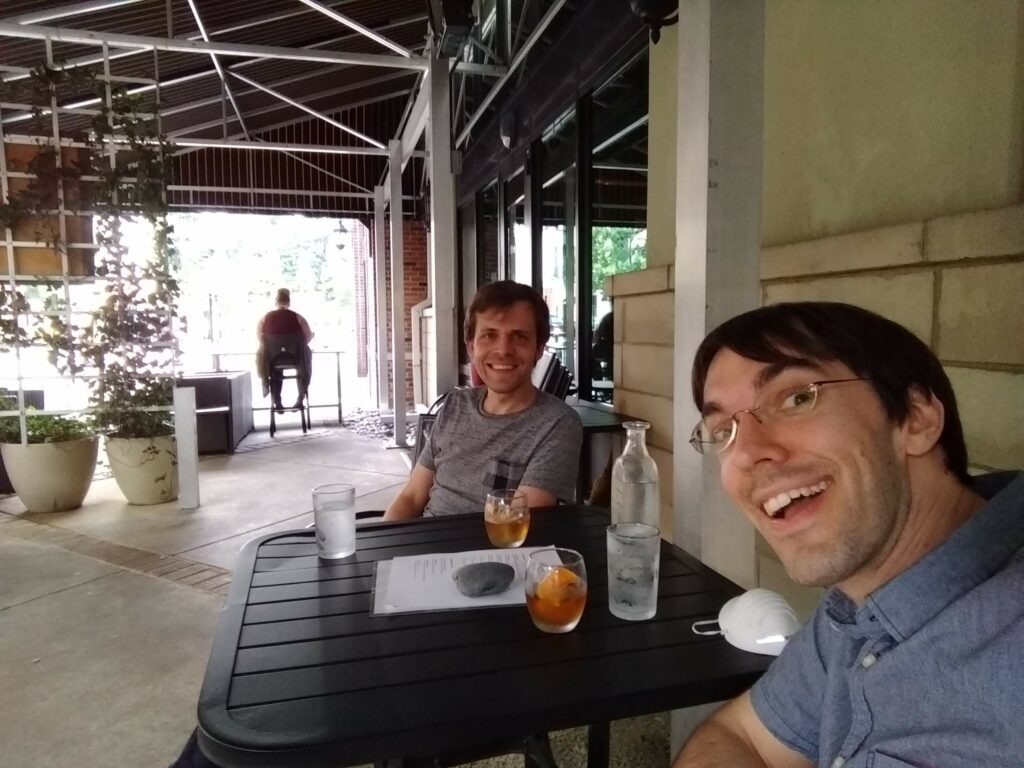
May 23, 2020: Brad and me, excited to return to our favorite restaurant for the first time in over two months. (It would be several more months before we could go inside.)
So where does all this leave us?
How have we changed? Are we better off now? Are we worse?
The events of 2020 sparked a lot of tension and conflict. But at least in our community, local leaders say they actually managed to get better at working together.
“All of our jurisdictions are different,” says Hillsborough Mayor Jenn Weaver, “and sometimes there are tensions there, and disagreements, and things we struggle over – but we also talk a lot about ‘One Orange,’ and our general outlook as a county, (and) that experience really drove that home to me, that those differences (can be) just so easily put aside.”
And in spite of all the worry about how our economies might be transformed, Chapel Hill Mayor Pam Hemminger says some things actually haven’t changed at all.
“Developers and investors were still calling us all during COVID,” she says. “We were stunned. We thought people were walking away from stuff, but no.”
“Are they coming to you with the same proposals that they had three years ago?” I ask.
“Tweaked a little bit, but it’s pretty much (the same), flex commercial office space,” she says. “We were just impressed that we still had all this interest. Even though people were saying ‘people are going to work remote, no more office workers,’ we’re still getting people interested in building commercial here.”
But there may be one way in which we might change – again, for the better.
State Representative Renee Price says that after three very challenging years for the arts, local communities may have a big incentive to focus on that in the future.
“Communities are redefining themselves,” she says. “You know, after people spend hours behind their computer, doing work and earning money, they want to go out and do something. So I think there’s hopefully going to be more of an emphasis on arts, and culture, and crafts, and – life.”
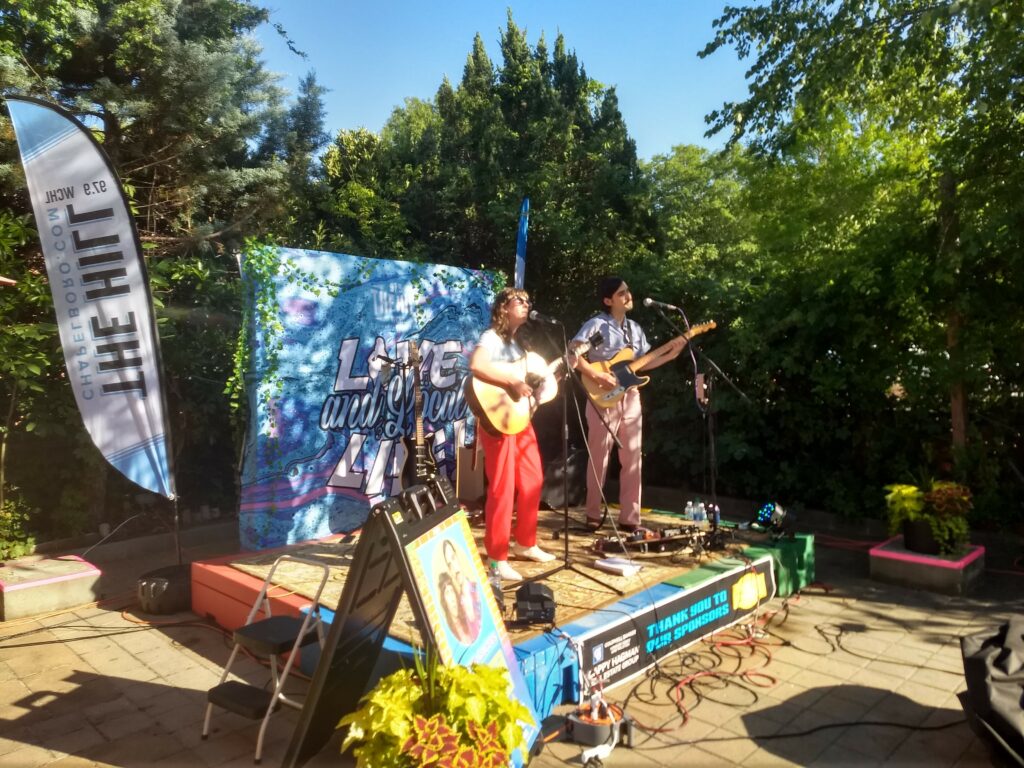
June 17, 2021: with music venues largely closed, we tried to support local musicians in various ways – including an outdoor summer concert series called Live & Local Live.
Okay – so where does all this leave our lives?
How much have we changed our day-to-day existence? And how much are we trying to return to normal?
At Kidzu Children’s Museum, Jamie DeMent Holcomb sees families wrestling with those questions every day.
“We see a range of things,” she says. “Mostly we see families who are just trying their best, who are more and more starting to want to get their kids out in public and to do things again that they did before the pandemic.”
What does Jamie Holcomb remember?
She talks about the first day after Orange County dropped its mask mandate, when Kidzu decided to switch to its own sort of hybrid model: some days with masks required, other days where you could have no mask at all.
“We were so nervous the first day,” she says. “We were like, ‘What’s it gonna be like? Will there be backlash?’ And (then) there was one dad and his daughter (without masks), everyone else was totally masked.”
“Was everyone fine with the dad and his daughter?” I ask.
“They kept their distance!” she says. “It was really interesting. Dad and daughter had a very wide berth. No one was rude, (but) you could very much tell that people were giving them space…
“I mean, it’s one of the mental health things. We all have these very strange reactions now. When you stop and think about it – it’s like, two years ago I would’ve been totally offended if I saw someone walking towards me veer away. But now…”
I nod. “Why are you not veering away? It’s just basic politeness at this point!”
“And we’ve got to figure out what our programs look like moving forward,” she continues.
Like: how do we have more outdoor programs? How do we do our (indoor) programming in a way that makes sense spatially? How do we do it in a way that makes all families comfortable? How many people can we let into a space for a program? And how can we do this program in ways where maybe there’s less touching of objects? (That’s) the antithesis of what you usually do in a children’s museum!
(And that) brings in virtual programming and technology. Usually in a children’s museum, you want everything to be hands on. You want everyone to be playing with the wooden blocks and the soft toys and things that are tactile. But now we’re thinking about how we can bring technology into the space, (so) children can engage in ways that are very interactive, but maybe less tactile.
It’s this totally evolving situation: we are trying very hard to listen to the children and hear what they want and what they need, but we also have to listen to the parents who are saying, ‘this is what I demand and this is what we absolutely need for my child’s safety.’ But then we also have to think about where we’re going in the future…and as museum professionals and early childhood education experts, how do we predict the future, and how do we help children and families get ready for what this is all going to look like.
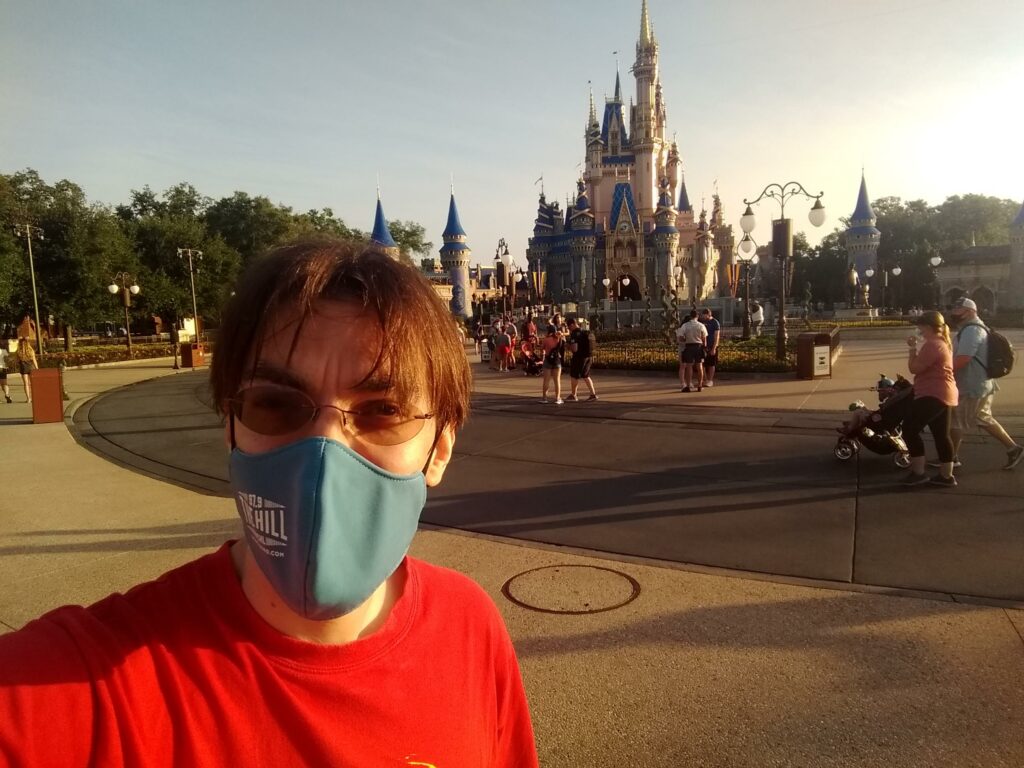
April 29, 2021: on the air, I gave people the same advice all through the pandemic: “Wear a mask, wash your hands, keep your distance, get the vaccine – and then live your life.” I did obey my own rules.
So what is this all going to look like? Or what should it all look like?
I talk to Quintana Stewart, Orange County’s health director, who’s been our go-to resource for guidance for the last three years.
“It’s like trying to find that balance,” she says. “We still have to live, we have to trust (that) we’re going to be okay, we’re going to get through this. But also (we should be) maintaining the safety measures that we know worked.”
“Anything else you want to add?” I ask. We’re starting to wrap up.
“Just happy to be in Orange County to go through this,” she says. “(I’m) very grateful and appreciative of the residents who trusted us in public health, (and) believed in us, (and) were willing to follow us – and thankful for all the elected leaders and government leadership for all their support. I couldn’t have chosen a better place to be during this pandemic.”
So how do we want to end?
I want to end on something positive. Something hopeful. Something that ties this all together, in a way that allows us to remember what we had and recover some of it, but that also leaves us smarter and wiser and better.
I’ll leave you with Jaki Shelton Green:
“Around the third or fourth day of COVID – we were outside. My husband and I were just taking a walk, and we were standing in the yard, and I said, ‘be quiet, listen.’ And he was like, ‘what are we listening to?’ And I said, ‘You can hear the earth breathe…’
“There were no airplanes, no cars on our streets. We’re not hearing sirens. I mean, it was nothing. And I am sure I could hear the earth breathing.
“And in that moment, I thought how metaphoric that is. It’s the breath, that this disease, this illness, has taken from us. Our breath. Because Mother Nature has been saying for generations: ‘I can’t breathe.’ She’s been telling us: ‘I can’t breathe.’
“And I think that it’s a time to listen – and to heed that call.”
Click here for the entire 15-part series.
Chapelboro.com does not charge subscription fees, and you can directly support our efforts in local journalism here. Want more of what you see on Chapelboro? Let us bring free local news and community information to you by signing up for our biweekly newsletter.

